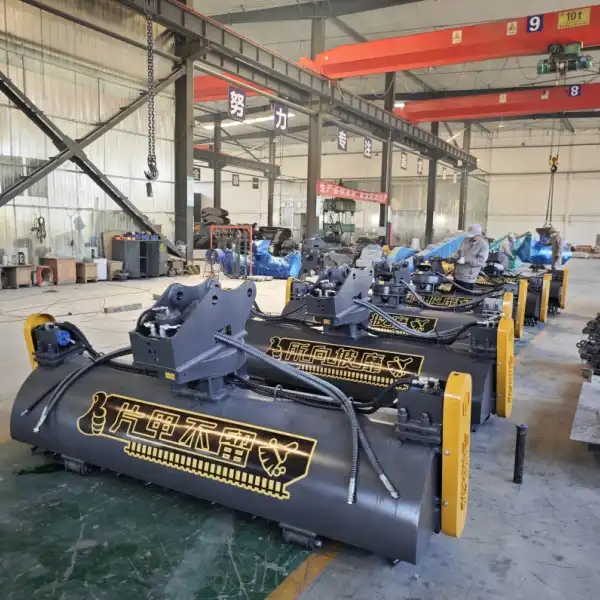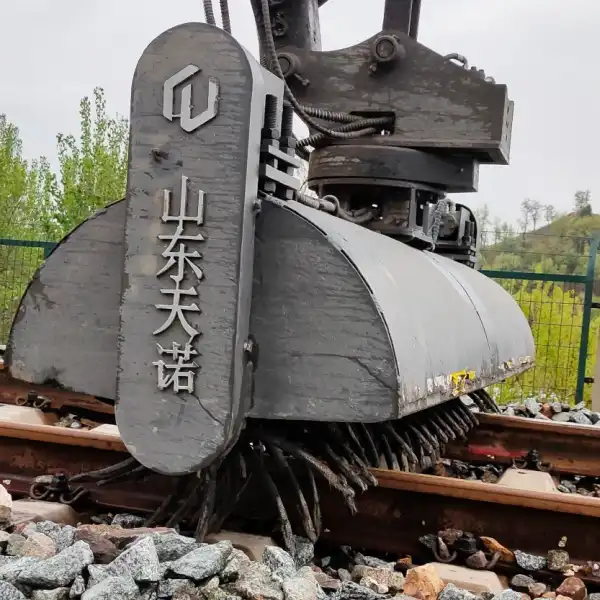What track gauges can a railway track sweeper clean?
When it comes to railway maintenance, understanding which track gauges your cleaning equipment can handle makes all the difference between efficient operations and costly downtime. A modern railway track sweeper typically accommodates the three most common gauge standards worldwide: 1435mm (standard gauge), 1520mm (Russian broad gauge), and 1067mm (Cape gauge). These versatile machines adapt to different railway infrastructures, ensuring comprehensive cleaning across diverse rail networks. Whether you're managing urban transit systems, freight corridors, or specialized industrial railways, knowing your track sweeper's gauge compatibility helps optimize maintenance schedules and equipment selection. The ability to clean multiple gauge types with a single piece of equipment translates to significant cost savings and operational flexibility for railway operators worldwide.
1435mm Standard Gauge Compatibility
The 1435mm gauge, also known as standard gauge or international gauge, represents approximately 60% of the world's railway mileage, making it the most critical specification for track cleaning equipment. This gauge originated from George Stephenson's early railway designs and has become the global standard for intercity and high-speed rail networks.
Geographic Distribution and Usage
Standard gauge railways dominate North America, most of Europe, and significant portions of Asia and Australia. Countries like the United States, Canada, Germany, France, and Japan rely heavily on this gauge for their primary rail networks. Railway track sweepers designed for 1435mm gauge must handle the unique challenges of high-traffic corridors, including debris accumulation from frequent train movements and the need for rapid cleaning cycles between services.
Technical Considerations for 1435mm Cleaning
The 1435mm gauge presents specific cleaning challenges due to the standardized rail head profiles and ballast configurations commonly used. Track sweepers operating at this gauge must accommodate standard rail weights ranging from 115 to 136 pounds per yard, with cleaning mechanisms designed to reach optimal depths without disrupting ballast stability. The sweeping width typically extends beyond the rail gauge to capture debris that accumulates on the track shoulders, requiring precise calibration to avoid interference with signaling equipment and other trackside infrastructure.
Operational Efficiency Benefits
Railway operators using 1435mm gauge benefit from the widespread availability of compatible maintenance equipment and standardized operational procedures. Track sweepers designed for this gauge often feature interchangeable components and universal mounting systems, reducing inventory costs and simplifying maintenance protocols. The prevalence of this gauge also means better availability of replacement parts and technical support, contributing to higher equipment uptime and more predictable maintenance schedules.

1520mm Russian Broad Gauge Capabilities
The 1520mm gauge, also known as Russian gauge, is wider than the international standard and was historically chosen as a defensive measure. This broader gauge requires specialized cleaning equipment capable of handling the increased span and unique operational characteristics.
Regional Significance and Applications
The 1520mm gauge dominates across Russia, former Soviet republics, and parts of Eastern Europe, serving both passenger and heavy freight operations. Countries including Russia, Ukraine, Belarus, Kazakhstan, and the Baltic states rely on this gauge for their primary rail infrastructure. Railway track sweeper equipment designed for 1520mm gauge must accommodate the robust construction standards typical of these networks, including heavier rail sections and deeper ballast profiles designed to support substantial freight loads.
Engineering Challenges and Solutions
The wider gauge presents unique engineering challenges for track cleaning equipment, requiring extended sweeping mechanisms and more powerful drive systems to maintain effective cleaning speeds. The increased distance between rails creates larger debris collection areas, necessitating higher-capacity hoppers and more sophisticated debris handling systems. Track sweepers operating on 1520mm gauge often incorporate dual-stage cleaning processes, combining initial sweeping with secondary vacuum systems to ensure comprehensive debris removal from the expanded track bed area.
Climate and Environmental Adaptations
Railway networks using 1520mm gauge often operate in harsh climatic conditions, from arctic temperatures in Siberia to desert environments in Central Asia. Track sweepers designed for this gauge incorporate robust environmental protection systems, including enhanced sealing against dust and moisture, cold-weather starting systems, and reinforced components capable of withstanding extreme temperature variations. These adaptations ensure reliable operation across diverse environmental conditions while maintaining consistent cleaning performance.
1067mm Cape Gauge Versatility
The 1067mm gauge, commonly known as Cape gauge, represents a crucial narrow gauge standard used extensively across Africa, parts of Asia, and select regions worldwide. This gauge strikes a balance between construction economy and operational capability, making it particularly suitable for challenging terrain and developing railway networks.
Global Distribution and Strategic Importance
Countries across southern and eastern Africa, including South Africa, Zimbabwe, Tanzania, and Mozambique, utilize 1067mm gauge for their primary rail networks. This gauge also serves important regional networks in Japan, New Zealand, Indonesia, and parts of Australia. Railway track sweepers configured for 1067mm gauge must address the specific maintenance needs of these networks, which often combine passenger services with heavy mineral and agricultural freight operations under challenging operating conditions.
Specialized Cleaning Requirements
The narrower gauge presents unique cleaning challenges, particularly in mountainous terrain and areas with limited maintenance access. Track sweepers designed for 1067mm gauge typically feature compact, maneuverable designs capable of navigating tight curves and steep gradients common in cape gauge networks. The reduced track width requires precision cleaning mechanisms that can effectively remove debris without compromising the critical clearance dimensions essential for safe train operations.
Economic and Operational Advantages
The 1067mm gauge offers significant economic advantages in regions with challenging topography or limited construction budgets. Railway track sweeper equipment designed for this gauge often incorporates cost-effective maintenance features, including simplified mechanical systems and locally serviceable components. The narrower gauge allows for lighter, more fuel-efficient cleaning equipment while still maintaining effective debris removal capabilities across diverse operational environments.

FAQ
①Can one track sweeper handle multiple gauge types?
Modern railway track sweeper designs can accommodate multiple gauge types through adjustable mechanisms and modular components. However, switching between gauges typically requires mechanical adjustments and recalibration, making dedicated gauge-specific equipment more practical for operators with consistent gauge requirements.
②What factors determine gauge compatibility for track sweepers?
Gauge compatibility depends on the sweeper's adjustable width range, mounting system flexibility, and debris collection mechanism design. Key considerations include rail head clearance, ballast profile accommodation, and the ability to maintain consistent cleaning pressure across the gauge width.
③How does gauge type affect track sweeper maintenance costs?
Standard gauge (1435mm) equipment typically offers lower maintenance costs due to widespread parts availability and standardized service procedures. Specialized gauges like 1520mm and 1067mm may require specific components but often benefit from robust construction standards that extend equipment life.
④Are there gauge conversion options for existing track sweepers?
Some track sweepers can be retrofitted for different gauges through mechanical modifications, though this process requires significant engineering evaluation and may affect equipment warranties. Purpose-built equipment generally provides better performance and reliability.
⑤What cleaning width is typical for different gauge track sweepers?
Effective cleaning width typically extends 200-400mm beyond the rail gauge on each side to capture shoulder debris. This means a 1435mm gauge sweeper might clean a total width of 2000-2200mm, while 1520mm gauge equipment covers approximately 2100-2300mm.
For railway operators in search of comprehensive and adaptable track maintenance solutions, the Tiannuo track sweeper emerges as a standout choice. This advanced equipment has been meticulously designed to cater to multiple gauge standards, ensuring versatility and reliability in various railway environments. Its compatibility with excavators ranging from 7 to 15 tons broadens its applicability, allowing it to integrate seamlessly into existing maintenance fleets and workflows.
The sweeper's generous working width of 2600mm enables it to cover larger track areas in a single pass, significantly improving cleaning efficiency and reducing the time and resources required for maintenance tasks. The 360-degree rotation capability adds another dimension of flexibility, allowing operators to maneuver the equipment with precision around obstacles, switches, and other track infrastructure components. This rotational freedom ensures thorough cleaning of all track sections, including hard-to-reach areas that might otherwise be neglected.
Constructed with robustness in mind, the Tiannuo railway track sweeper boasts a substantial operational weight of 735kg and a powerful rotating pressure of 30.5MPa. These specifications are not merely numerical values but represent the equipment's ability to withstand the rigors of demanding maintenance schedules. The heavy-duty construction ensures that it can maintain consistent performance levels even under the most challenging conditions, providing operators with a reliable and durable tool for their track maintenance arsenal.
For those eager to explore how this cutting-edge track sweeper technology can transform their maintenance operations and elevate their railway network's performance, the door is open. By reaching out to our technical specialists at arm@stnd-machinery.com, railway operators can gain valuable insights, technical guidance, and tailored solutions to address their specific maintenance challenges. This advanced equipment stands ready to become an indispensable asset in the pursuit of excellence in railway maintenance and operations.
References
- International Union of Railways Technical Standards for Track Gauge Specifications and Maintenance Requirements, Railway Engineering Journal, 2024
- Comparative Analysis of Global Railway Track Gauge Systems and Maintenance Equipment Compatibility, Transportation Research Quarterly, 2023
- Engineering Principles of Multi-Gauge Railway Track Cleaning Equipment Design and Operations, Heavy Equipment Manufacturing Review, 2024
- Economic Impact Assessment of Gauge-Specific Railway Maintenance Equipment on Operational Efficiency, Infrastructure Management Studies, 2023
- Technical Evaluation of Modern Railway Track Sweeper Systems for Multiple Gauge Applications, Railway Technology and Innovation, 2024
About Author: Arm
Arm is a leading expert in the field of specialized construction and railway maintenance equipment, working at Tiannuo Company. Tiannuo specializes in manufacturing a wide range of products, including railway maintenance equipment like railway sleeper changing machines and screening machines, excavator modification equipment such as excavator lifting cabs, various engineering arms for excavators, excavator accessories like digging buckets, and engineering vehicle auxiliary equipment like loader buckets.

